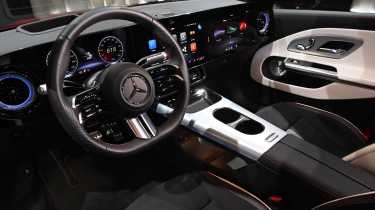An all-wheel-drive, dual-motor CLA350 model will come with the same battery pack, and range figures of between 416 and 478 miles. Power jumps to 348bhp in this variant, with the 0-62mph time dropping to 4.9 seconds. Both versions have a two-speed transmission on the rear motor that allows for punchier acceleration at low speeds and more effortless cruising at high speeds.
The CLA is able to achieve these figures thanks to a range of technical innovations, starting with the inclusion of an 800V electrical system for the first time in a Mercedes. As well as packaging in lighter and more compact hardware, it also allows for super-fast 320kW charging, which is capable of adding up to 200 miles in just 10 minutes.
Mercedes is also quoting very impressive efficiency ratings for the motors, ranging between 4.4 and 5.1mi/kWh, which is helped by a relatively sensible 2,050kg kerb weight and that slippery body. The complex design is an efficient one with a coefficient of drag that’s best in class at 0.21. This comes as no surprise considering Merc’s expertise in aero management, and with the new CLA’s mandate of being the brand’s most efficient EV, it was also essential to reach those challenging range targets. A heat pump is also standard across the range.
| Model | Range | Charging |
| Mercedes CLA 250+ EQ | 430-491 miles | 320kW |
| Mercedes CLA 350 EQ | 416-478 miles | 320kW |
What is the exterior and interior design like?
Fans of the current CLA will be happy to see the new model’s look is a natural evolution from the previous models, but there are lots of new design details that we’ll see across Merc’s future models. The swooping roofline, sleek windows and frameless doors all draw from previous CLA models, although everything sits a little higher on this new car, due to a thick floor designed to contain the batteries. Mercedes has tried to hide this with the use of black sills, but on most AMG Line cars the designers have added a chrome sill strip, which reverses this effect.

For all this, it’s the new CLA’s lighting that will grab more attention. This includes a complex front lighting arrangement that sees the main headlight units connected by a lightbar stretching across the car’s nose.


